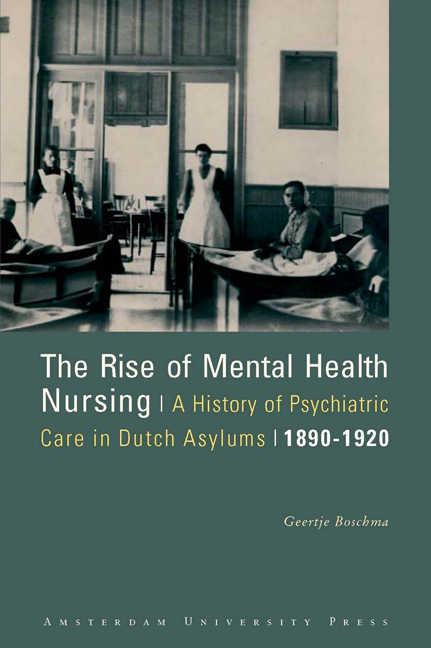Book contents
- Frontmatter
- Contents
- Acknowledgments
- Introduction
- Chapter I Asylum Reform Ideals: Personnel Matters
- Chapter II The Ideal of a Mental Hospital
- Chapter III Female Compassion: Mental Nurse Training Gendered Female
- Chapter IV The Burdensome Task of Nurses
- Chapter V Negotiating Class and Culture
- Chapter VI The Marginalization of Male Nurses
- Chapter VII Controversy and Conflict over the Social Position of Nurses
- Conclusion: The Politics of Mental Health Nursing
- Appendix
- Notes
- List of Illustrations
- List of Abbreviations
- List of Archives
- Bibliography
- Index
Chapter VI - The Marginalization of Male Nurses
Published online by Cambridge University Press: 28 January 2021
- Frontmatter
- Contents
- Acknowledgments
- Introduction
- Chapter I Asylum Reform Ideals: Personnel Matters
- Chapter II The Ideal of a Mental Hospital
- Chapter III Female Compassion: Mental Nurse Training Gendered Female
- Chapter IV The Burdensome Task of Nurses
- Chapter V Negotiating Class and Culture
- Chapter VI The Marginalization of Male Nurses
- Chapter VII Controversy and Conflict over the Social Position of Nurses
- Conclusion: The Politics of Mental Health Nursing
- Appendix
- Notes
- List of Illustrations
- List of Abbreviations
- List of Archives
- Bibliography
- Index
Summary
Nursing, a Respected Occupation – but not for Men
The conceptualization of nursing as women's work generated a gendered system of training and favored career opportunities for female nurses. This gendered ideology of nursing functioned as a selective mechanism that excluded male nurses. The process, however, was not only an ideological matter but also a result of the way the labor market developed. Men apparently had more options in the expanding labor market. In all asylums filling the positions for male nurses turned out to be more complex than hiring female nurses. Both Meerenberg and Franeker had to advertise the vacancies for male nurses, whereas they usually had enough spontaneous applicants for female positions. A gendered division of labor enhanced the influx of women into nursing, which was a reasonable career opportunity within the small range of work options for women.
Implicit in the social definition of nursing as women's work was the assumption that these women would be single. Paid employment for middleclass married women had not yet been debated, let alone accepted. The notion of a respected social position for men was different. Aspirations and social respect for working- and middle-class men included marriage, a home, and an income high enough to support a family. The gendered structure of nursing work prevented men from reaching such goals; traditionally, the social and economic aspects of the attendants’ work in asylums implied living in, a low income, and no opportunity for marriage or supporting a family. This had been the case since asylum reform had begun. The social position of the poor lower-class attendants reflected these characteristics, and the floating, often seasonal group of workmen and maids never stayed long in their positions.
Introducing nurse training was in part intended to raise the social position and aspirations of the lower class and in part to create a stable and disciplined workforce. This process was in many ways comparable to creating an industrial working class at that time. Yet for male nurses the aspiration to earn an income large enough to marry and sustain a family, and to attain a working day similar in length to that which their counterparts aspired in industry was difficult to realize.
- Type
- Chapter
- Information
- The Rise of Mental Health NursingA History of Psychiatric Care in Dutch Asylums, 1890–1920, pp. 175 - 196Publisher: Amsterdam University PressPrint publication year: 2003



